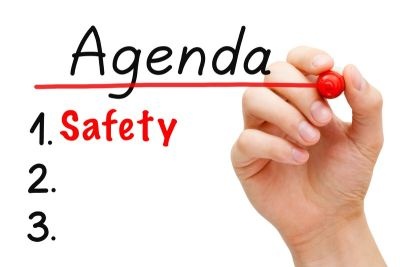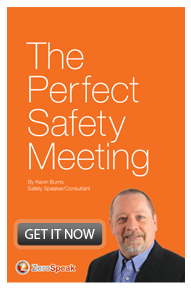Why Safety As First Agenda Item Fails
At management level meetings, safety isn’t about rules. It’s about how safety advances the organization.
 Companies are including safety more often in general meeting discussions. It’s commendable. Safety people have wished for a long time for safety to be a top agenda item in management and general staff meetings. Now it’s starting to happen in more and more organizations. But is there a plan on behalf of the Safety department to maximize the effectiveness of this new position? Is safety prepared for their moment in the sun?
Companies are including safety more often in general meeting discussions. It’s commendable. Safety people have wished for a long time for safety to be a top agenda item in management and general staff meetings. Now it’s starting to happen in more and more organizations. But is there a plan on behalf of the Safety department to maximize the effectiveness of this new position? Is safety prepared for their moment in the sun?
I was recently in attendance at a safety meeting of employees and contractors. As a kickoff to the event, the meeting chair asked if anyone had a safety moment they were willing to share. Crickets. Silence. He asked again and after what seemed like an eternity, a hand went up. The safety share was made. Another followed. And then one more. And then the meeting moved on to the next item on the agenda.
Personally, I dislike the idea of a safety moment anyway. Opening the floor with fingers-crossed and hoping that someone takes it up demonstates unpreparedness. Awkward silences reinforces that. Then there is the begging and pleading. “C’mon, someone’s gotta have something they wanna share.”
This is where safety looks amateurish. If it were the sales department and the attendees were asked to share a good news sales incident, there’d be little hesitation. Same for ideas for the staff Christmas Party or even a new marketing and promotions idea.
If safety is going to be given the number one place on the meeting agenda, it is up to the safety department to not squander that opportunity. Instead, take advantage of it. Kick off the meeting with professionalism and purpose.
Here are three things that Safety can do to ensure that they maximize their effectiveness on the meeting agenda:
1Prepare for it. Don’t wing it. Safety is all about preparedness except, apparently, when it comes time to involve others. (See above “safety moment” comment). It’s diminishing when there's little preparation of a compelling statement or big kickoff on safety. The Finance department doesn’t show up at the meeting unprepared. Sales doesn’t show up unprepared. Anything that involves money and numbers usually have prepared a report. You don’t “wing” Finance or Accounting. Safety must ensure that someone is pre-assigned to address safety on the agenda. Prepare to give a relevant account of how safety is helping move the organization forward. Prepare for each meeting with a relevant and appropriate representation of safety’s accomplishments. Give that person at least a few days to prepare something compelling.
2Inform, don’t preach. You’ve been to a funeral where there was a service performed by a priest or minister. If the dearly departed was a church-goer, the officiant would speak in familiar ways about the person who passed. If the person who passed was not a regular church-goer, the minister might use the opportunity, instead, to try to save a few souls. You would be preached at, maybe even shamed for turning your own back on your brethren. You end up feeling guilty and shamed. That’s awkward. Funerals are an inopportune time to preach in the hopes of saving a few souls. Management and general meetings are a lousy time to preach safety and try to convert attendees to your safety cause. Even safety meetings are not supposed to be your personal crusade to convert the safety-heathens. Instead, talk about safety performance with a positive and optimistic view. Talk about the momentum that safety is making. (I am assuming that there are plenty of good news stories in safety and that it has a positive momentum. If otherwise, don’t sugar-coat it).
3Integrate into other departments. The Safety department representative must demonstrate how safety integrates with the other departments. You need to have a basic understanding of how each department functions. You need to be able to show how when safety does its job, other departments benefit. If you want safety to become a corporate foundational value, then you had better be prepared to defend those values. How does safety performance affect HR? How does safety contribute to reduced attrition and turnover numbers? How is safety making it possible for sales to secure more and bigger business? How does safety build teamwork between senior managers and front-line employees? How can Marketing or Communications help safety to build a better overall corporate culture? Safety is not a stand-alone department anymore. Safety must be integrated.
 People will follow a solid leader. You, as the safety representative at a management or staff meeting, are going have to be articulate and eloquent. At management level meetings, safety isn’t about rules. It’s about how safety advances the organization. Prepare that argument.
People will follow a solid leader. You, as the safety representative at a management or staff meeting, are going have to be articulate and eloquent. At management level meetings, safety isn’t about rules. It’s about how safety advances the organization. Prepare that argument.
Kevin Burns helps organizations integrate caring for and valuing employees through their safety programs. In addition to consulting with and facilitating discussions between all levels of management and supervisory, Kevin can also give engaging, entertaining and inspiring presentations to front-line employees at safety meetings. Kevin Burns is a management consultant, safety leadership speaker and author of 9 books. He is based in Calgary, Canada.
©2016 ZeroSpeak Corporation and Kevin Burns.
No part of this post may be reproduced without the expressed consent of the author.


